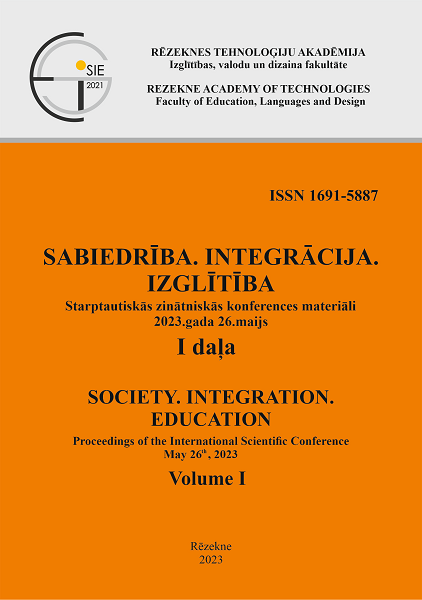DEVELOPING A CULTURE OF MINDFUL LEARNING: CHALLENGES, BENEFITS, AND OPPORTUNITIES
DOI:
https://doi.org/10.17770/sie2023vol1.7111Keywords:
mindfulness, mindful learning, mindfulness practice, positive changes, self-awareness skills, self-regulation, student`s personal growthAbstract
Learning is an individual process for each student. People can be aware of own learning or do not think about it at all in the diverse situations of life. However, in the pedagogical reality, the awareness of students' learning is essential as it contributes to self-regulation of behaviour and self-reflection of actions, striving towards continuous self-development. It is important to be aware of oneself mentally and physically, understanding and accepting own thoughts or feelings. The integration of all areas of personal development becomes relevant, as changes in one area are linked to changes in another. Awareness of own learning directs the learner towards the social, emotional and academic dimension, including not only awareness of the knowledge and acquired skills, but awareness of own goals, motivations, emotions, interests, the personal relevance of the learning content and also the variability of the current situation, strategies for future learning, and other elements of the learning process. Mindfulness can also be seen as a powerful 'antidote' to common mental health problems, e.g. fatigue, exhaustion, apathy, anxiety and difficulty in concentrating. Mindfulness practices can be implemented at schools as an element of the lesson, but it is also important to purposefully create a culture of mindfulness at the institutional level, which can be greatly facilitated by the professional development of teachers. Mindfulness is a mental state of being reflective in the present moment. It provides the ability to live intensely in the present moment, acceptance of own thoughts and feelings, a sense of perspective and the ability to cope with stressful situations through conscious concentration. The aim of this publication is to analyze the theoretical aspects of mindfulness, the possibilities of facilitating the learning process through mindfulness practices, as well as to carry out empirical research evaluating 16-19-year-old students` self-awareness skills, the phenomenon of the presence of mindfulness in their learning process and its impact on their learning outcomes.
References
Bishop, S. R., Lau, M., Shapiro, S., Carlson, L. E., Anderson, N., & Carmody, J. (2004). Mindfulness: A Proposed Operational Definition. Clinical Psychology, 11, 230-241. DOI: 10.1093/clipsy.bph077
Cantor, P., Osher, D., Berg, J., Steyer L., & Rose, T. (2018). Malleability, plasticity, and individuality: How children learn and develop in context. Applied Developmental Science, 23(4), 307–337. DOI: https://doi.org/10.1080/10888691.2017.1398649
Duval, S., & Wicklund, R. A. (1972). A theory of objective self awareness. Academic Press. DOI: https://doi.org/10.1016/S0065-2601(08)60252-X
Fenigstein, A., Scheier, M. F., & Buss, A. H. (1975). Public and private self-consciousness: Assessment and theory. Journal of Consulting and Clinical Psychology, 43(4), 522–527. DOI: https://doi.org/10.1037/h0076760
Fink, L. D. (2013). Creating Significant Learning Experiences: An Integrated Approach to Designing College Courses. San Francisko: John Wiley & Sons Jossey Bass.
Gayl, C. L. (2018). Student Academic, Social, and Emotional Learning An examination of five key strategies. Education Digest. Vol. 83 Issue 5, p.17-24.
Hofmann, W., Baumeister, R. F., Förster, G., & Vohs, K. D. (2012). Everyday temptations: An experience sampling study of desire, conflict, and self-control. Journal of Personality and Social Psychology, 102(6), 1318–1335. DOI: https://doi.org/10.1037/a0026545
Immordino-Yang, M. H., Darling-Hammond, L., & Krone, C. (2018). The brain basis for integrated social, emotional, and academic development: How emotions and social relationships drive learning. Washington, D.C.: The Aspen Institute National Commission on Social, Emotional, and Academic Development. Retrieved from: https://files.eric.ed.gov/fulltext/ED596337.pdf
Kaufman, N. (2019). Mindfulness for Students: Embracing Now, Looking to the Future. Brighton: Leaping Hare Press.
López-González, L., Amutio, A., Oriol, X., & Bisquerra, R. (2016). Habits Related to Relaxation and Mindfulness of High School Students: Influence on Classroom Climate and Academic Performance. Revista de Psicodidáctica, 21(1), 121-138 DOI: 10.1387/RevPsicodidact.13866
Mussey, S. (2019). Mindfulness in the Classroom. New York: Routledge.
Osher, D., Cantor, P., Berg, J., Steyer L., & Rose, T. (2018). Drivers of human development: How relationships and context shape learning and development. Applied Developmental Science, 24(1), 6–36. DOI: https://doi.org/10.1080/10888691.2017.1398650
Rogers, C. R. (1961). On Becoming a Person. The Therapists View of Psychotherphy. Boston: Houghton Mifflin Company.
Turkheimer, E., Haley, A., Waldron, M., d’Onofrio, B., & Gottesman, I. I. (2003). Socioeconomic status modifies heritability of IQ in young children. Psychological Science, 14(6), 623–628. DOI: 10.1046/j.0956-7976.2003.psci_1475.x
Zenner, C., Herrnleben-Kurz, S., & Walach, H. (2014). Mindfulness-based interventions in schools – A systematic review and meta-analysis. Frontiers in Psychology, 5, 603-623. DOI: https://doi.org/10.3389/fpsyg.2014.00603
Zins, J. E., & Elias, M. J. (2007). Social and emotional learning: Promoting the development of all students. Journal of Educational & Psychological Consultation, 17(2-3), 233–255. DOI: https://doi.org/10.1080/10474410701413152






